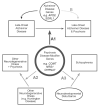Genetics of psychosis in Alzheimer's disease: a review
- PMID: 20157235
- PMCID: PMC2942073
- DOI: 10.3233/JAD-2010-1274
Genetics of psychosis in Alzheimer's disease: a review
Erratum in
- J Alzheimers Dis. 2010;20(4):1263
Abstract
In and of itself, late-onset Alzheimer's disease (AD) can be a devastating illness. However, a sub-group of AD patients develop psychosis as the disease progresses. These patients have an added burden of greater cognitive impairment, higher rates of institutionalization, and higher mortality than AD patients without psychosis. While the etiopathogenesis such as psychosis in AD (AD+P) is not known, mounting evidence accrued over the past ten years indicates that AD+P represents a distinct phenotype with a genetic basis. Elucidating the genetic mechanism of AD+P is crucial if better pharmaceutical treatments are to be developed for these patients. The goal of this review is to summarize what is currently known regarding the genetic basis of psychosis in AD. Specific attention is given to familial aggregation and heritability, linkage to chromosomal loci, and associations of candidate genes of APOE and the monoamine neurotransmitter system.
Figures

Similar articles
-
Genetics of psychosis of Alzheimer disease.Am J Med Genet B Neuropsychiatr Genet. 2017 Jan;174(1):27-35. doi: 10.1002/ajmg.b.32413. Epub 2016 Jan 12. Am J Med Genet B Neuropsychiatr Genet. 2017. PMID: 26756273 Free PMC article. Review.
-
Cumulative effect of COMT and 5-HTTLPR polymorphisms and their interaction with disease severity and comorbidities on the risk of psychosis in Alzheimer disease.Am J Geriatr Psychiatry. 2006 Apr;14(4):343-51. doi: 10.1097/01.JGP.0000192491.50802.c3. Am J Geriatr Psychiatry. 2006. PMID: 16582043
-
Apolipoprotein E and alpha-1-antichymotrypsin genotypes do not predict time to psychosis in Alzheimer's disease.J Geriatr Psychiatry Neurol. 2002 Spring;15(1):24-30. doi: 10.1177/089198870201500106. J Geriatr Psychiatry Neurol. 2002. PMID: 11936240
-
Neuregulin-1 polymorphism in late onset Alzheimer's disease families with psychoses.Am J Med Genet B Neuropsychiatr Genet. 2005 Nov 5;139B(1):28-32. doi: 10.1002/ajmg.b.30219. Am J Med Genet B Neuropsychiatr Genet. 2005. PMID: 16082692
-
Psychosis in Alzheimer's disease.Biol Psychiatry. 2014 Apr 1;75(7):542-52. doi: 10.1016/j.biopsych.2013.08.020. Epub 2013 Oct 6. Biol Psychiatry. 2014. PMID: 24103379 Free PMC article. Review.
Cited by
-
Apolipoprotein E-ε4 allele predicts escalation of psychotic symptoms in late adulthood.Schizophr Res. 2019 Apr;206:82-88. doi: 10.1016/j.schres.2018.12.010. Epub 2018 Dec 21. Schizophr Res. 2019. PMID: 30584027 Free PMC article.
-
Association Between Psychosis Phenotype and APOE Genotype on the Clinical Profiles of Alzheimer's Disease.Curr Alzheimer Res. 2018;15(2):187-194. doi: 10.2174/1567205014666170829114346. Curr Alzheimer Res. 2018. PMID: 28847281 Free PMC article.
-
Genome-wide association study of Alzheimer's disease with psychotic symptoms.Mol Psychiatry. 2012 Dec;17(12):1316-27. doi: 10.1038/mp.2011.125. Epub 2011 Oct 18. Mol Psychiatry. 2012. PMID: 22005930 Free PMC article.
-
Exploring the Therapeutic Impact of Repetitive Transcranial Magnetic Stimulation (rTMS) in Individuals With Alzheimer's Disease: A Comprehensive Narrative Review.Cureus. 2025 May 27;17(5):e84885. doi: 10.7759/cureus.84885. eCollection 2025 May. Cureus. 2025. PMID: 40575244 Free PMC article. Review.
-
Psychosis in Alzheimer's disease in the national Alzheimer's disease coordinating center uniform data set: clinical correlates and association with apolipoprotein e.Int J Alzheimers Dis. 2011 Mar 23;2011:926597. doi: 10.4061/2011/926597. Int J Alzheimers Dis. 2011. PMID: 21461363 Free PMC article.
References
-
- Levy-Lahad E, Wasco W, Poorkaj P, Romano DM, Oshima J, Pettingell WH, Yu CE, Jondro PD, Schmidt SD, Wang K. Candidate gene for the chromosome 1 familial Alzheimer’s disease locus. Science. 1995;269:973–977. - PubMed
-
- Goate A, Chartier-Harlin MC, Mullan M, Brown J, Crawford F, Fidani L, Giuffra L, Haynes A, Irving N, James L. Segregation of a missense mutation in the amyloid precursor protein gene with familial Alzheimer’s disease. Nature. 1991;349:704–706. - PubMed
-
- Sherrington R, Rogaev EI, Liang Y, Rogaeva EA, Levesque G, Ikeda M, Chi H, Lin C, Li G, Holman K. Cloning of a gene bearing missense mutations in early-onset familial Alzheimer’s disease. Nature. 1995;375:754–760. - PubMed
-
- Rovelet-Lecrux A, Hannequin D, Raux G, Le Meur N, Laquerriere A, Vital A, Dumanchin C, Feuillette S, Brice A, Vercelletto M, Dubas F, Frebourg T, Campion D. APP locus duplication causes autosomal dominant early-onset Alzheimer disease with cerebral amyloid angiopathy. Nat Genet. 2006;38:24–26. - PubMed
-
- Sleegers K, Brouwers N, Gijselinck I, Theuns J, Goossens D, Wauters J, Del Favero J, Cruts M, van Duijn CM, Van Broeckhoven C. APP duplication is sufficient to cause early onset Alzheimer’s dementia with cerebral amyloid angiopathy. Brain. 2006;129:2977–2983. - PubMed
Publication types
MeSH terms
Substances
Grants and funding
LinkOut - more resources
Full Text Sources
Medical
Miscellaneous

